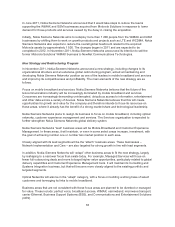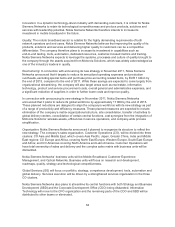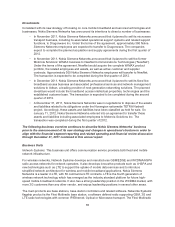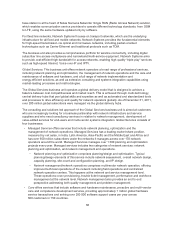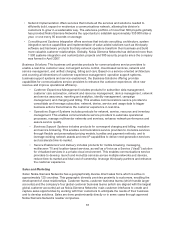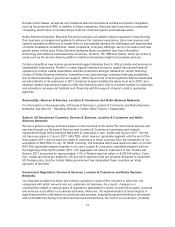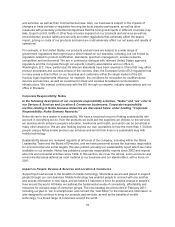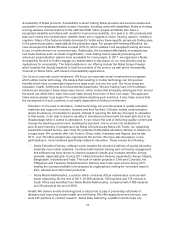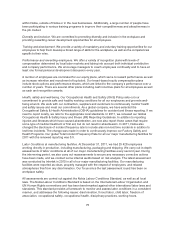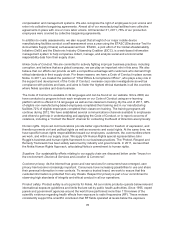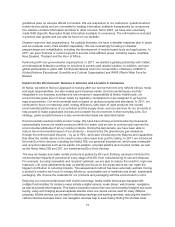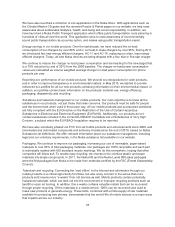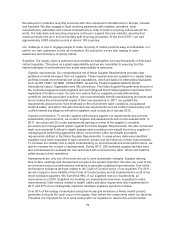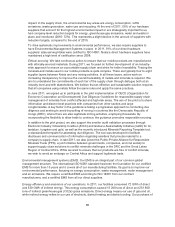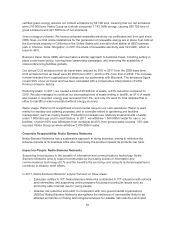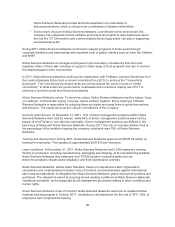Nokia 2011 Annual Report Download - page 75
Download and view the complete annual report
Please find page 75 of the 2011 Nokia annual report below. You can navigate through the pages in the report by either clicking on the pages listed below, or by using the keyword search tool below to find specific information within the annual report.Accessibility of Nokia products. Accessibility is about making Nokia products and services usable and
accessible to the greatest possible number of people, including users with disabilities. Nokia is working
to bring wireless communications to the estimated 600 million people worldwide who have a
recognized disability and others with needs for improved accessibility. Our goal is to offer products that
take such needs into consideration, whether these are in regards to vision, hearing, speech, mobility or
cognition. Many of the features initially developed to better serve these specific groups are finding uses
in the general population, especially as the population ages. For people with hearing difficulties, we
have developed the Nokia Wireless Loopset (LPS-5), which enables t-coil equipped hearing aid users
to use a mobile device in a convenient way. Additionally, the increased affordability of smartphones
has made features such as screen magnification, voice dialing, text-to-speech processing and
enhanced personalization options more accessible for more people. In 2011, we organized a Nokia
Accessibility Summit to further engage our stakeholders in discussion on our new direction and its
implications for accessibility. The latest additions to our offering include the Nokia Screen Reader,
which enables the visually impaired to hear the contents of the screen, as well as the Accessibility
Channel on Nokia Store, with dozens of accessibility applications.
Our focus in corporate social investment. We focus our corporate social investments on programs
which utilize mobile technology. We believe that investing in mobile technology can bring social
benefits which have a meaningful impact on a large scale, but at a low cost. Our focus areas are
education, health, livelihoods and environmental awareness. We are making many of the software
solutions we develop in these areas open source, which means that third-party developers from around
the world can utilize them, tailor them and make money from them in their own ways. This approach
helps ensure greater local support for organizations adopting such solutions. It also helps ensure that
the development of such solutions is not solely dependent on Nokia’s involvement.
Education. In the area of education, mobile technology can provide access to quality education
materials and support to teachers, learners and their families. Critically, mobile communication
allows the delivery of education to people, instead of requiring the delivery of people to education.
In that sense, it can help to improve equality in educational achievement because girls tend to be
disadvantage when it comes to attendance. It can reduce the cost of delivering quality content and
change the teaching environment, enabling the teachers’ role to evolve into facilitators of
peer-to-peer learning. Concepts such as Nokia Life (previously Nokia Life Tools), our expanding
subscription-based service, also show the potential of affordable education delivery to citizens on
a large scale. We currently offer Life Tools in China, India, Indonesia and Nigeria, and by late
2011, over 40 million people have experienced the service. We have also developed, or are
participating in, more initiatives specifically related to education. These include the following:
•Nokia Education Delivery, software which enables the structured delivery of quality education
materials over mobile networks. Combined with teacher training and community engagement,
this software has been shown to improve academic results and increase retention among
students, especially girls. During 2011, Nokia Education Delivery expanded to Kenya, Nigeria,
Bangladesh, Indonesia and India. This built on earlier projects in Chile and Colombia, the
Philippines and Tanzania. Nokia Education Delivery was made open-source during 2011,
making the concept available to be adopted by organizations looking for innovative ways to
train, educate and inform their personnel.
•Nokia Mobile Mathematics, a solution which combines official mathematics curricula with
social networking. By the end of 2011, 20 000 students, 700 teachers and 172 schools in
South Africa had benefited from Nokia Mobile Mathematics, compared with 4 000 students
and 30 schools at the end of 2010.
Health. We believe mobile technology has a critical role to play in preventing outbreaks of
diseases and improving human health and well-being. We offer applications and services, and
work with partners to conduct research. Nokia Data Gathering, a platform which helps any
73


